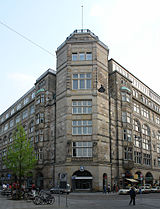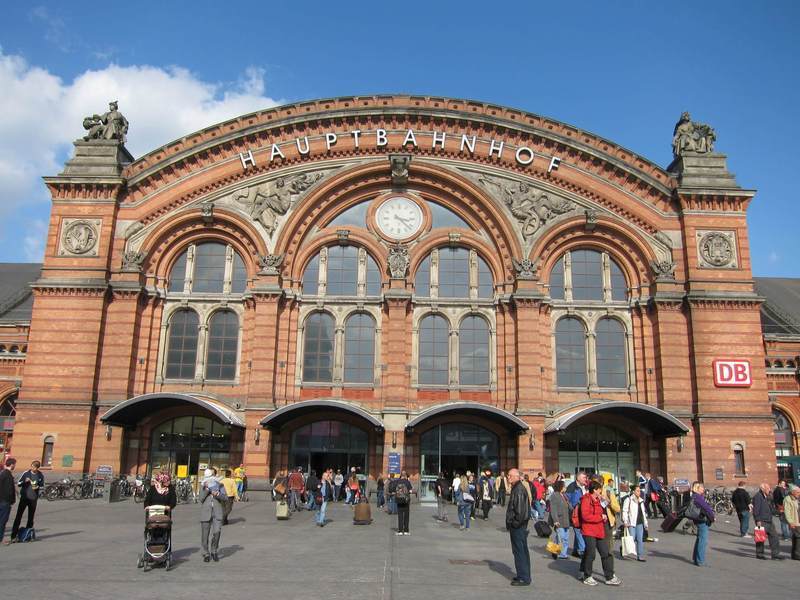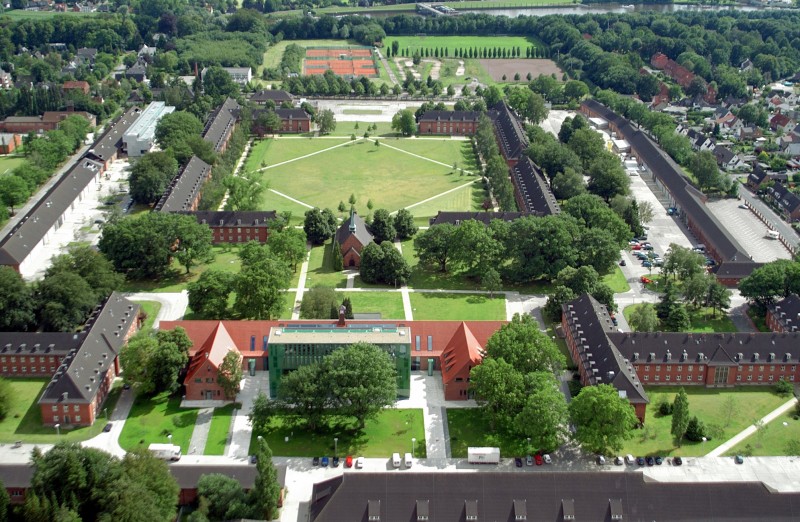Bremen Exchange
The Bremen Stock Exchange until 2007 was one of the eight German regional exchanges. In 2000, the floor trading was abandoned in 2007, the last operating units were disbanded. The assets of the Exchange Holding went to the newly established Foundation Bremen Stock Exchange. From the return of science, research and culture to benefit.
In the late Middle Ages, the marketplace, and Liebfrauenkirchhof in Bremen were the most important movement of goods and trade places. At the beginning of the 17th century, the desire came after an exchange. In the year 1613/14, therefore, was allowed on the southern edge of the churchyard of Our Lady about 28 small huts tear. Six years later came here 21 with stone slabs covered cellars for wine storage. The resulting free surface was baptized and immediately exchange here, most business activities took place.
The Old Exchange
Due to the dilapidated state of the vault and the growing trade volumes, the city of Bremen on March 14, 1682 adopted I. Exchange Rules, on the basis of the architect Jean Baptiste Broëbes 1687 began to build a one-story building in the Baroque style above the basement. According to the plans of Gislher of Warneck a second floor was built in the years 1734-1736.
In the Old Stock Exchange, there was a building in the style of the Baroque. On the ground floor the trading floor and the office of the Lotterieeinnehmers were. The office was remodeled in the late 18th century and set up as a bookstore. In the new second floor were two small and one large hall for concerts, weddings, receptions and host similar events. The basement of the building was probably even then connect to the Ratskeller. Trading in the Old Stock Exchange focused primarily on broker, commodity and foreign exchange transactions, but also shares were popular.
After the invasion of Napoleon Bonaparte and his troops, the stock exchange was temporarily closed by the French. This led in September 1811 to move to the Kramer House and the City Hall, where could be traded. In October 1813 - after the defeat of the French - could the stock market open for business in the building again on Liebfrauenkirchhof.
In 1816, the merchant Convention adopted borne by the Senate of Bremen II Exchange Rules. First, however, the economic situation of the merchants was not promising, but in the 1820s the situation improved and soon the old stock exchange proved insufficient as the claims. 1849 was the III. Exchange Rules published, which transferred the supervision of the business of the Chamber of Commerce. This received support from 1853 by the newly founded Bremer Booksellers Association. In addition, there were in the building and the upper, the lower and the Commercial Court and the Civil Chambers of the District Court of Bremen.
1864 trade were relocated to the New Exchange at the market place.
The disused Old Stock Exchange burned down in 1888. After demolition of the ruins of the basement of the building has been lowered and now forms part of the Bachuskellers, a portion of the Bremer Council cellar.
The New Exchange
In 1855 the Bremen Chamber of Commerce and the Booksellers Association decided to erect a new building. They let on the east side of the marketplace 1860-1863 demolish seventeen old gabled houses and the Wilhadikapelle. Under the leadership of Heinrich Müller was born in the years 1861 to 1864 a new commercial building. Its inauguration was celebrated on 5 November 1864.
The New Stock Exchange at the market place was a great neo-gothic building with the Schütting similar portal staircase and two towers. The interior was designed by many renowned artists of the time. Among others, the painter Arthur Fitger and P. Janssen and the sculptor Diedrich Samuel Kropp participated in these activities. The building had a large hall, several office rooms, a meeting room and offices, which were also used for the Bremen State Parliament. In addition, was still in the basement of a public restaurant.
Even at the start of trading in the New Exchange Securities Trading hardly took place in Bremen. Were carried out mainly exchange and commodity transactions. However, this changed in the 1890s. On January 1, 1890 provided the stock exchange, so that area who dealt in shares and other securities, new policies on, in consequence of which the Bremen Stock Exchange increasingly gained in importance and soon found the connection to other European institutions. With the entry into force of the Reich Exchange Act on June 23, 1896, it became a service with a public mission. Through the establishment of the independent Cotton Exchange trading on the commodity market was down significantly.
In the wake of the November Revolution of 1918, the New Stock Exchange stepped briefly into the political limelight, as the politician Alfred Henke the seizure of power by a workers' and soldiers as well as the resolution of the Senate and the citizens explained in a hall of the building on November 14. From this committee at the beginning of the following year, the Bremen Soviet Republic developed.
In 1934 the New Stock Exchange was closed and transferred to the Bremen Stock trading on the Hanseatic Stock Exchange in Hamburg.
Exchange outbuildings
The Börsenhof A, Am Dom 5A, was a stock exchange building adjacent to the new stock exchange. While designed by Heinrich Müller 1861-1864 in the Neo-Gothic style main building after heavy war damage in 1943 had to give way to the house of citizenship in the course of reconstruction, the office building has been preserved. From 2000 to 2001, the semi-circular building was renovated and stocking plans of the Bremen architect Schomers and Schürmann.
Important are the triple Arkadenumgänge on columns with finely carved positions bud capitals and arches closed by a glass roof atrium. The exempted in the room curved staircase creates its own tower in the courtyard.
Conservation
The Börsenhof A was found in 1992 as Bremer monument under protection: See list of cultural monuments in Bremen-Mitte.
World War II and its aftermath
On 20 December 1943, facing the main market building burned after an air raid completely. Get remained only the eastern market outbuildings. The Bremen Stock Exchange was reopened with the consent of the U.S. occupation force on 16 February 1949. Stock exchange meetings were initially in the Savings Bank, and later in a room in Schütting instead.
The surviving part of the old stock exchange has been restored and increased. The ruins of the main building was about twelve years standing, the demolition took place in 1955. Was not until 1957, sold the Chamber of Commerce the property to the city. Then the building of the Bremen City Parliament got there after plans by the architect Vasily Luckhardt 1965/66.
In 1980, the stock market moved into the Bremer Bank building at Domshof. Ten years later, she moved to the location near the Bremen's market square building of the former Schroeder Bank in Upper Street 2 -12.
The Bremen Stock Exchange drove early advance the use of computers in securities trading. As of 1990, the trade was extensively supported by the bifos program. In subsequent years, other programs have been used for this purpose included such as BOSS CUBE and BÖGA (now XONTRO ) and IBIS ( successor system: Xetra). In addition, other measures have been taken to make particularly for private investors exchange trading more attractive, eg the reduction of the minimum number of pieces for the continuous trading and the significant expansion of the trading period. In addition, the Bremen stock exchange operated by the establishment of subsidiaries in the IPO advisory and securities trading and settlement for third parties, particularly smaller banks and brokerages. This set of measures resulted in a significant increase in trading activity from 1990.
In early 2000 the trading floor was finally abandoned in favor of the computer trade, whereupon the institution due to the changed requirements once again moved to the offices and sat down with about 30 securities dealers and brokers in the Kohlhökerstraße in the building of the Deutsche Bundesbank. In 2002, there was a ten percent stake in the NASDAQ Germany AG - along with the NASDAQ Europe Ltd ( 50%), the Berlin Stock Exchange (10%), comdirect (7.5 %), Commerzbank (7.5% ) and the Dresdner Bank ( 15%). The goal was the establishment of a new stock exchange in Germany after the pattern of the NASDAQ in the United States. However, the expectations could not be fulfilled.
In March 2003, the Bremen Stock Exchange merged with the Berlin Stock Exchange for public securities exchange " Börse Berlin- Bremen". In 2005, the carrier company of Bremen Stock Exchange was sold after the failure of cooperation with the NASDAQ at the Swiss Exchange. In 2007, the state contract was terminated with the Berlin stock exchange. The Foundation Bremen Stock Exchange was founded out of the assets of the merged into Bremen Stock Exchange Holding BWB BWB Securities Bank and Securities IPO advisory.
The Foundation Bremen Stock Exchange since September 2007 as a charitable foundation. It shall promote science, research and culture.









